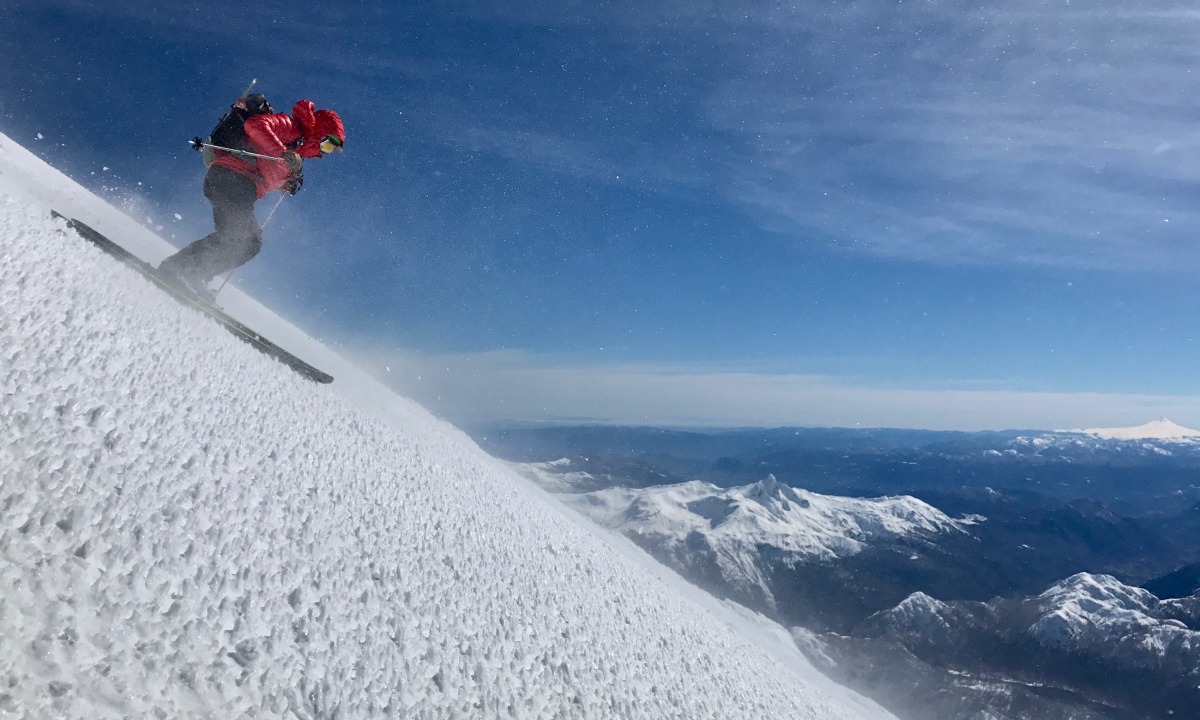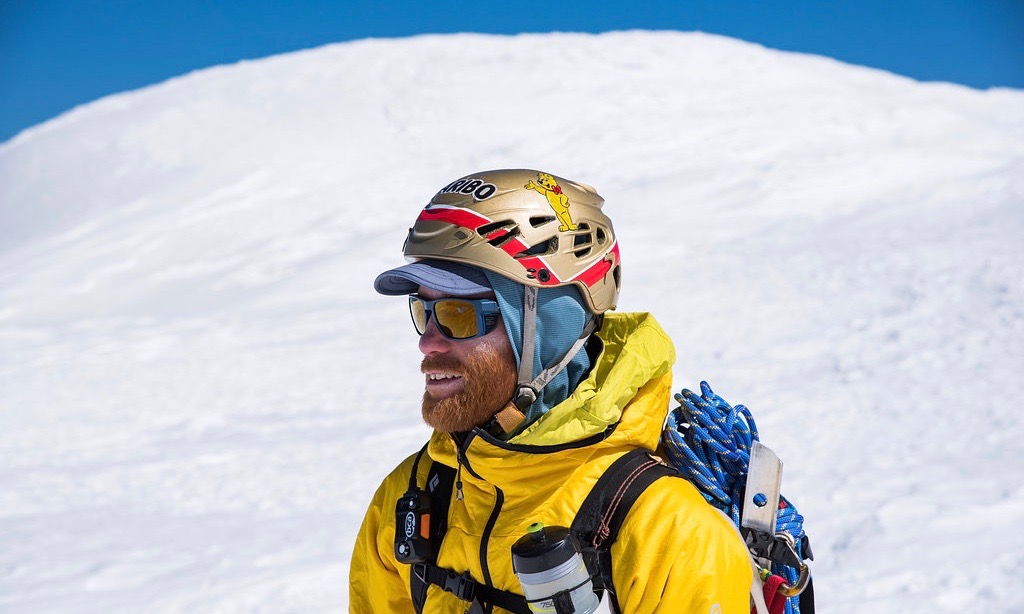
Hoods on helmets on hoods on hats. The ginger beard is a favorite springtime layering piece for sun protection. Layering is especially important on big exposed mountains where the climate can change many times like here, leaving the summit of Mt Rainier, WA. photo @alwaysadventuring.
Layering thoughts from skin to shell
It’s a beautiful crisp morning at the trailhead and powder fever is peaking. Cold hands swing like violent, off-time grandfather clock pendulums. Jumping jacks are jumped. Soon enough though, you are sweating from head to toe and your backpack hosts a jumbled mess of poly nylon insulated something or others. Just when it appears that ski touring might be best done in beach wear, the winds pick up and clouds roll in. Oh the joys! We have all been a swampy mess at some point only to have a weather change or summit winds strip the heat from our damp bodies like flash frozen seafood.
There is a myriad of apparel available for us ski tourists these days. The standard baselayer, mid layer, and shell system has spawned hybrids and sub-sects such as active insulation and increasingly breathable and protective shell fabrics. These evolutions are extending the useable temperature or activity range for each layer in a system, however, the need for a system still remains. Here are some tips that have worked for me with current apparel offerings and what I have seen work well with ski partners.
Base Layer
Wools or synthetics here, no cotton derivatives. Wool (generally the soft merino variety) will provide more warmth generally and then retain that warmth while wet. It is also more expensive initially and will have to be replaced sooner. Synthetics (polyester blends) will transport wetness away from the body better, and be less likely to induce sweating to begin with. Synthetic fibers do retain more odor since bacteria grows better on the fibers.
The decision between the two should usually be made with these properties in mind. I prefer wool, or mostly wool socks for odor prevention warmth retention while wet. Feet will always sweat, and for me, almost always be cold at some point. Currently I am wearing the Dissent GFX compression wool or wool hybrids. CEP fit fantastically but seem to conspire in tandem with my liners to develop a wicked stench. I have also been sporting Lenze 5.0 heated socks on colder days. These wool battery powered socks are spendy, but fantastic for people with circulation issues.
I go with a two part base layer system for top and bottom, an ultralight poly running T-shirt (Dynafit Traverse is my favorite) and poly boxer brief next to skin almost every day. North Face’s L2 Powergrid hoodie goes over the T in the winter months, Outdoor Research’s Echo sun hoodie during springtime. I remove the T shirt from underneath the sun hoodie on the warmest of spring days. For fast paced tours or warm days, try ditching the long johns altogether or swapping for thin running shorts over synthetic underwear. When wanting a bit more warmth on the legs, the Helly Hansen Lifa Merino pant is a great 2 for 1; synthetic Lifa technology next to skin layered with Merino for warmth retention.
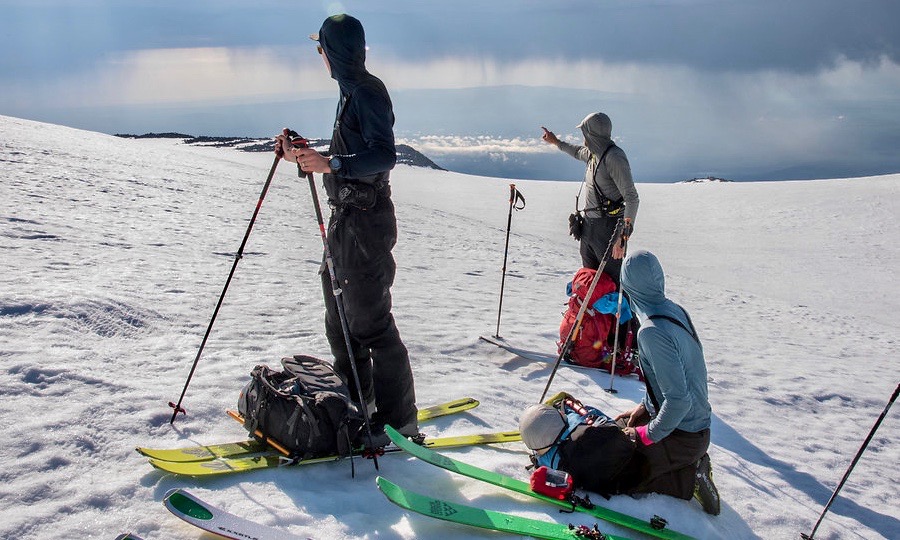
Springtime often means dropping down to a sun hoody. Cal and I here in the OR Echo, Drew with a BD offering during a break on Mt. Adams, WA. photo: @alwaysadventuring
Mid Layer?
I usually find the use of a traditional midlayer, a dedicated insulating piece between base and shell layers, to be a cumbersome carryover from resort skiing. Insulation is rarely needed on an uphill, whereas weather protection often is. This requires the backcountry traveler to remove the shell, then insulator when warm and then put the shell back on to continue; vise versa when chilled.
Enter the “puffy over” method, where the shell becomes the second layer, with the insulator being the final piece of the puzzle. I will often wear my shell the entire day up and down, and only swap the insulator on and off as needed while warming in the morning, coming on to a breezy ridge or for the descent. I used an Arcteryx Psiphon climbing softshell before the advent of FutureLight. Now, the TNF Summit Series LT jacket, downsized once to fit trimly under the puffy, stays on car-to-car on all but the hottest of days. This method also requires a bit more of the top insulating piece — hood, tall face cuff, larger wrist cuffs, and touch of weather resistance.
For those moving at a slower pace, enduring super cold environs, or preferring traditional methods, there are great active insulation pieces coming out. Polartec Alpha, commissioned by the US military, was the first active insulation, and many sporting outerwear manufacturers have developed their own in-house. These synthetic lofts are extremely air permeable and hydrophobic layups that open more with heat and/or body movement to drain your swamp. I used the North Face’s Ventrix system, both jacket and knickers, extensively in the much colder and slower travel of Denali National Park with fantastic results. We have a test piece of the new VerticalX Air technology from Outdoor Research in the field currently, stay tuned for a review.
Worth a mention here is your avalanche beacon. Sorry, no new active insulating transceivers to report on, but if you use the chest harness, the layer which you place it over is important. You don’t want to remove and/or potentially drop it as your body temperature warms. Additionally, burying it as you re-layer on a summit is not ideal. This access conundrum led me to switch to pocketing mine in the pants. Neither method has become a gold standard amongst avalanche professionals as there are pros and cons for either. For this discussion on layering, if you keep the beacon in the chest harness, make sure that it is on your person and easily accessible with gloves on at all times.
Shells
Find a shell material that suits your environmental needs. Many inland skiers would be pleasantly surprised if they ditched the old three layer Gore-Tex for a softshell pant. If you’ll be moving all day and transitioning on your feet there is generally no need for a hardshell pant in intercontinental and continental snowpacks. Wash and re-treat with softshell DWR often to maintain water resistance. Newer supple and more breathable shells, headlined by the ubiquitous FutureLight, are worth a serious look for one stop shopping.
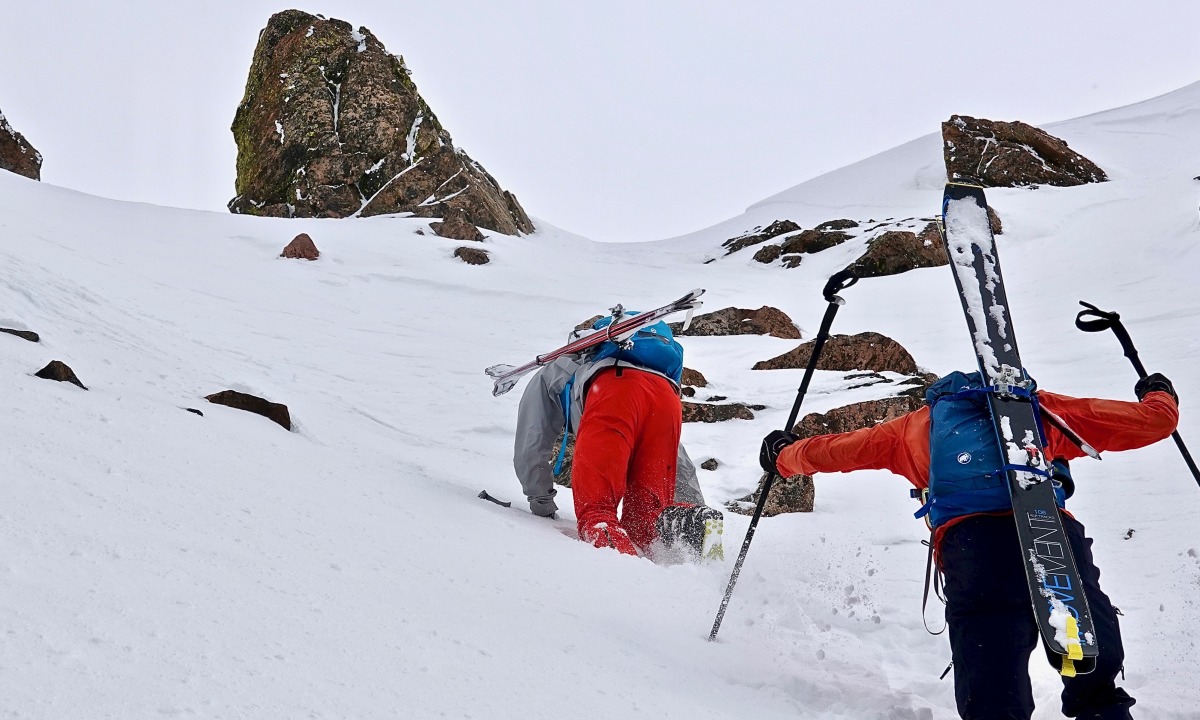
Moving quickly in thin shell pieces without mid layers last spring. Doug sets the punchy faceted boot pack last spring in FutureLight LT while Chris opts for a thin Arcteryx climbing softshell top and mid weight bottom.
I can hear our PNW brothers and sisters and others in maritime climes loud and clear, “Hey dude, I would be soaked from either precip or sweat with some of your continental methods.” Yes indeed your best system will often be hardshell over a base layer, though clearer or colder days may afford you some dry-country luxuries.
Head and Hands
Thin trail running style caps with mesh backs and no top button make for a great all day ‘head base layer’. The brim keeps the sun off the face and/or snow out of glasses and goggle vents while forehead sweat is captured by the fabric behind the brim. Add and subtract hoods, beanies and helmets over top as the day dictates. Keeping your head cool goes a long way with the rest of your body, as the head’s large blood supply near the surface acts as a great radiator.
Hand sweat management is crucial and usually dealt with multiple pairs of gloves. I have cold hands and start most tours in mid to heavy weight gloves, keeping the ultralights handy to switch to at the first sign of sweat. Some backcountry skiers are adopting the rando-race inspired two-in-one systems. These thin softshell gloves have a flip over mitt stored in a small pocket in the wrist. However, I’ve found the mitt usually feels loose with sloppy dexterity and a wet palm/fingers means a wet glove regardless of the built in overmitt.
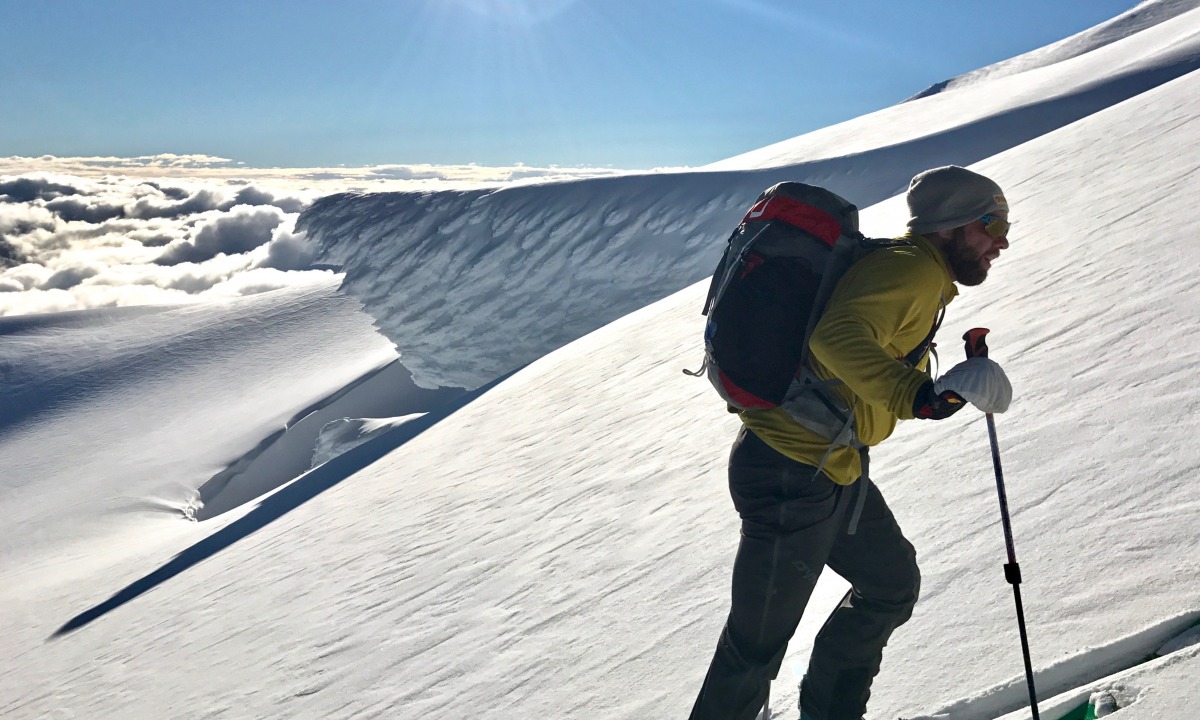
Doug utilizing flip over mitt of the CAMP G Comp Warm, or Mickey Mouse gloves as he calls them, on Volcan Villarica, Chile.
Would love to hear from readers on their systems as well, particularly if our female readers would like to elaborate on what works best for them.
A few notes from M
Weighing in here as a lady in the bunch. For the under, under layers, I rarely go for a sports bra. The thick webbing characteristic of most bras will turn my back into a sweaty and then clammy mess when I’ve been moving hard with a pack on. I’ll typically opt for a synthetic bralette with only very thin straps if a racer back. I differ from Gary in that I almost always opt for a light merino baselayer up top (Icebreaker 200 weight) with a quarter zip. I’m constantly amazed at how much temperature regulation I can get simply from adjusting how much of my neck is covered.
For bottoms, I forgo a base layer on warm (40 degree plus) days, and employ either a light merino or synthetic tight for colder ones. If it’s a very cold day, I’ll wear TNF L2 over my merino top. I’m not a bit fan of fleeces, but find the L2 breathable and minimal enough to not be cumbersome while adding a comfortable dose of warmth. On par with Gary, I often opt for the shell over base layers and employ the puffy (down or synthetic) over shell at the top. Also worth noting, I always carry at least one buff that either insulates my neck or gets pulled into a headband over my cap.
On March 22nd 2021, Gary Smith tragically died in an avalanche outside of Beaver Creek Resort in Colorado. Since 2018, Gary has been a frequent and insightful contributor to WildSnow. From Christmas Eve spent at the Wildsnow Field HQ cabin, to testing gear and sharing his love for steep skiing around the world, he was a pillar of the ski touring community and will be greatly missed.

